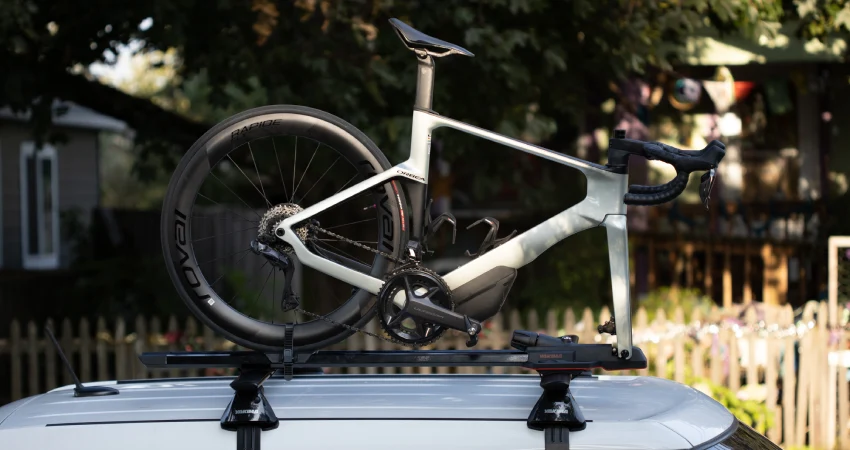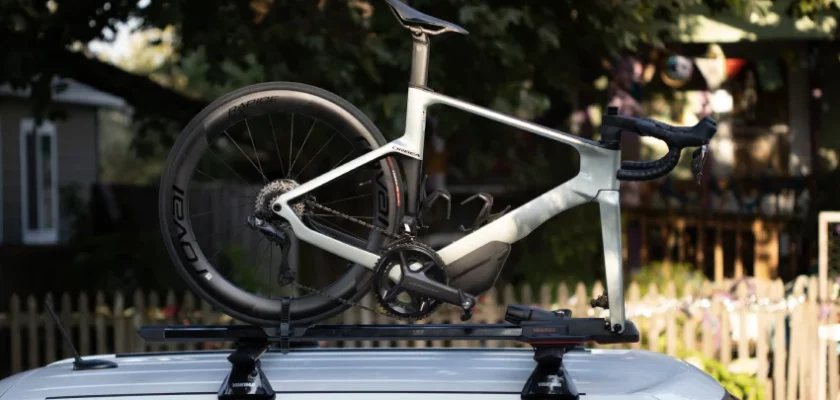Can you put a bike on a roof rack? The answer to this question is a resounding yes! If you’ve ever found yourself pondering this thought while considering a road trip or an outdoor adventure with your beloved bicycle, you’re in the right place.
Roof racks offer a convenient and efficient way to transport your bike, allowing you to free up space inside your vehicle and keep your bike secure.
In this article, we’ll delve into the ins and outs of bike transportation on a roof rack. We’ll explore the different types of roof racks available, discuss the necessary equipment and accessories, and provide some valuable tips to ensure a smooth and safe journey for your two-wheeled companion.
So, let’s dive right in and discover how you can comfortably and confidently put a bike on a roof rack!
Biking On A Roof Rack: Can You?

Whether you’re heading to the mountains for a thrilling downhill ride or simply taking your bike to a new neighborhood for a leisurely spin, finding a suitable method of transport is essential. One popular option is using a roof rack, but can you put a bike on a roof rack?
The Advantages of Using a Roof Rack
Roof racks offer several benefits when it comes to transporting your bike. Here are some advantages:
- Extra Space: By using a roof rack, you free up space inside your vehicle, allowing you to bring along other passengers or carry additional gear.
- Access: Unlike rear-mounted racks or hitch-mounted carriers, a roof rack doesn’t obstruct your access to the trunk or tailgate, making it easier to load and unload other items.
- Compatibility: Most roof racks are designed to be versatile and can accommodate different types of bikes, including road bikes, mountain bikes, and even fat bikes.
Securing Your Bike on a Roof Rack
Now that we’ve established the advantages, let’s talk about how to secure your bike properly on a roof rack. Ensuring your bike is secure not only protects it from potential damage during transport but also ensures the safety of other drivers on the road.
- Invest in a Quality Roof Rack: Before you start loading your bike, make sure your roof rack is sturdy and designed to carry bicycles. Look for racks specifically designed for bikes to minimize the risk of accidents or damage.
- Use a Bike Mount: Most roof racks come with a bike mount that attaches to the crossbars. These mounts usually consist of a front fork mount and a rear wheel strap. Follow the manufacturer’s instructions for proper installation.
- Remove Front Wheel: To maximize stability, it’s recommended to remove the front wheel of your bike. This not only allows for a more secure and compact fit on the roof rack but also reduces wind resistance during transit.
- Secure the Front Fork: Place the front fork of your bike into the bike mount, ensuring it is fully seated and secure. Tighten the mount according to the manufacturer’s specifications.
- Secure the Rear Wheel: After securing the front fork, use the rear wheel strap to tightly fasten the rear wheel to the roof rack. Double-check that the straps are snug and secure before hitting the road.
- Check for Stability: Give your bike a gentle shake to ensure it is firmly attached to the roof rack. If there is any excessive movement or instability, recheck the mount and straps to ensure proper installation.
Important Considerations
While roof racks offer a convenient and secure way to transport your bike, there are a few important considerations to keep in mind:
- Height Clearance: With a loaded bike on your roof, the overall height of your vehicle will increase. Be cautious of low-clearance structures like parking garages, tree branches, or drive-thru entrances to avoid potential accidents and damage.
- Weight Limit: Every roof rack has a maximum weight limit. Ensure that the combined weight of your bike and the roof rack does not exceed this limit to maintain safety and prevent damage to your vehicle.
- Wind Resistance: When you have a bike on your roof rack, it creates additional wind resistance. This may impact your vehicle’s aerodynamics, leading to decreased fuel efficiency. Keep this in mind when planning long-distance trips.
- Mounting Difficulty: Loading and unloading a bike onto a roof rack can be challenging, especially for individuals with limited physical strength or mobility. Consider your personal abilities and the frequency of bike transportation before opting for a roof rack.
- Protection from Theft: Bikes on roof racks are generally more visible and exposed, making them potential targets for theft. Consider investing in additional security measures such as bike locks or surveillance cameras for peace of mind.
Alternative Bike Transportation Options
While roof racks are a popular choice, there are alternative options available for transporting your bike. Here are a few:
- Rear-Mounted Racks: These racks attach to the rear of your vehicle and are a great option if you prefer easy access to your bike without the hassle of mounting it on the roof.
- Hitch-Mounted Carriers: Ideal for vehicles with a trailer hitch, these carriers offer a convenient and sturdy platform for transporting your bike. They are easier to load and unload compared to roof racks.
- Folding or Collapsible Bikes: If you frequently travel with your bike, consider investing in a folding bike. These bikes are designed to fold into a compact size, allowing for easy storage and transport.
Frequently Asked Questions
1. Can I put a bike on a roof rack?
Yes, you can put a bike on a roof rack. Roof racks designed for bikes allow secure transportation without obstructing your vehicle’s trunk or rear visibility.
2. Is it safe to put a bike on a roof rack?
When properly installed and secured, it is generally safe to put a bike on a roof rack. However, it’s important to consider the height clearance and be cautious when entering low-clearance areas such as parking garages.
3. Will putting a bike on a roof rack damage my car?
When used correctly, a roof rack should not damage your car. However, it’s essential to follow the manufacturer’s instructions for installation and weight limits to avoid any potential damage or accidents.
4. Can I leave my bike on a roof rack overnight?
Leaving your bike on a roof rack overnight is generally not recommended, as it may be more exposed to theft or damage. It’s best to remove the bike and secure it indoors or use additional security measures if you need to leave it unattended for an extended period.
5. Can I put multiple bikes on a roof rack?
Most roof racks are designed to hold multiple bikes. However, it’s important to check the weight capacity of your specific roof rack and consider any potential height and stability issues that may arise from carrying multiple bikes.
Final Thoughts
In conclusion, the question remains: can you put a bike on a roof rack? The answer is a resounding yes. Roof racks are designed to securely transport bikes, providing a convenient and space-saving solution for cyclists.
By properly mounting the bike on the roof rack and using additional straps or accessories, you can ensure a safe and stable journey. So, next time you plan a cycling adventure or need to transport your bike, consider utilizing a roof rack to make your journey hassle-free and enjoyable.

